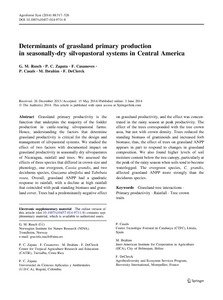About Springer
Throughout the world, we provide scientific and professional communities with superior specialist information – produced by authors and colleagues across cultures in a nurtured collegial atmosphere of which we are justifiably proud.
We foster communication among our customers – researchers, students and professionals – enabling them to work more efficiently, thereby advancing knowledge and learning. Our dynamic growth allows us to invest continually all over the world.
We think ahead, move fast and promote change: creative business models, inventive products, and mutually beneficial international partnerships have established us as a trusted supplier and pioneer in the information age.
Members:
Resources
Displaying 386 - 390 of 1195Determinants of grassland primary production in seasonally-dry silvopastoral systems in Central America
Grassland primary productivity is the function that underpins the majority of the fodder production in cattle-rearing silvopastoral farms. Hence, understanding the factors that determine grassland productivity is critical for the design and management of silvpastoral systems. We studied the effect of two factors with documented impact on grassland productivity in seasonally dry silvopastures of Nicaragua, rainfall and trees.
Determinants of grassland primary production in seasonally-dry silvopastoral systems in Central America
Grassland primary productivity is the function that underpins the majority of the fodder production in cattle-rearing silvopastoral farms. Hence, understanding the factors that determine grassland productivity is critical for the design and management of silvpastoral systems. We studied the effect of two factors with documented impact on grassland productivity in seasonally dry silvopastures of Nicaragua, rainfall and trees.
Should conservation of biodiversity involve private land? A Q methodological study in Poland to assess stakeholders’ attitude
Biodiversity conservation is gradually shifting its dependency on public protected areas to take a more holistic ecosystem and landscape approach that includes private lands in addition to public lands. However, effective practice of biodiversity conservation on private land also depends on landowners’ attitude and their willingness to participate and cooperate. This study focuses on Poland where conservation on private land is a relatively new concept but it is slowly gaining recognition, especially after its accession into the European Union.
Longevity of rodenticide bait pellets in a tropical environment following a rat eradication program
Invasive rodents (primarily Rattus spp.) are responsible for loss of biodiversity in island ecosystems worldwide. Large-scale rodenticide applications are typically used to eradicate rats and restore ecological communities. In tropical ecosystems, environmental conditions rapidly degrade baits and competition for baits by non-target animals can result in eradication failure. Our objective was to evaluate persistence of rodenticide baits during a rat eradication program on Palmyra Atoll; a remote tropical atoll with intense competition for resources by land crabs.




